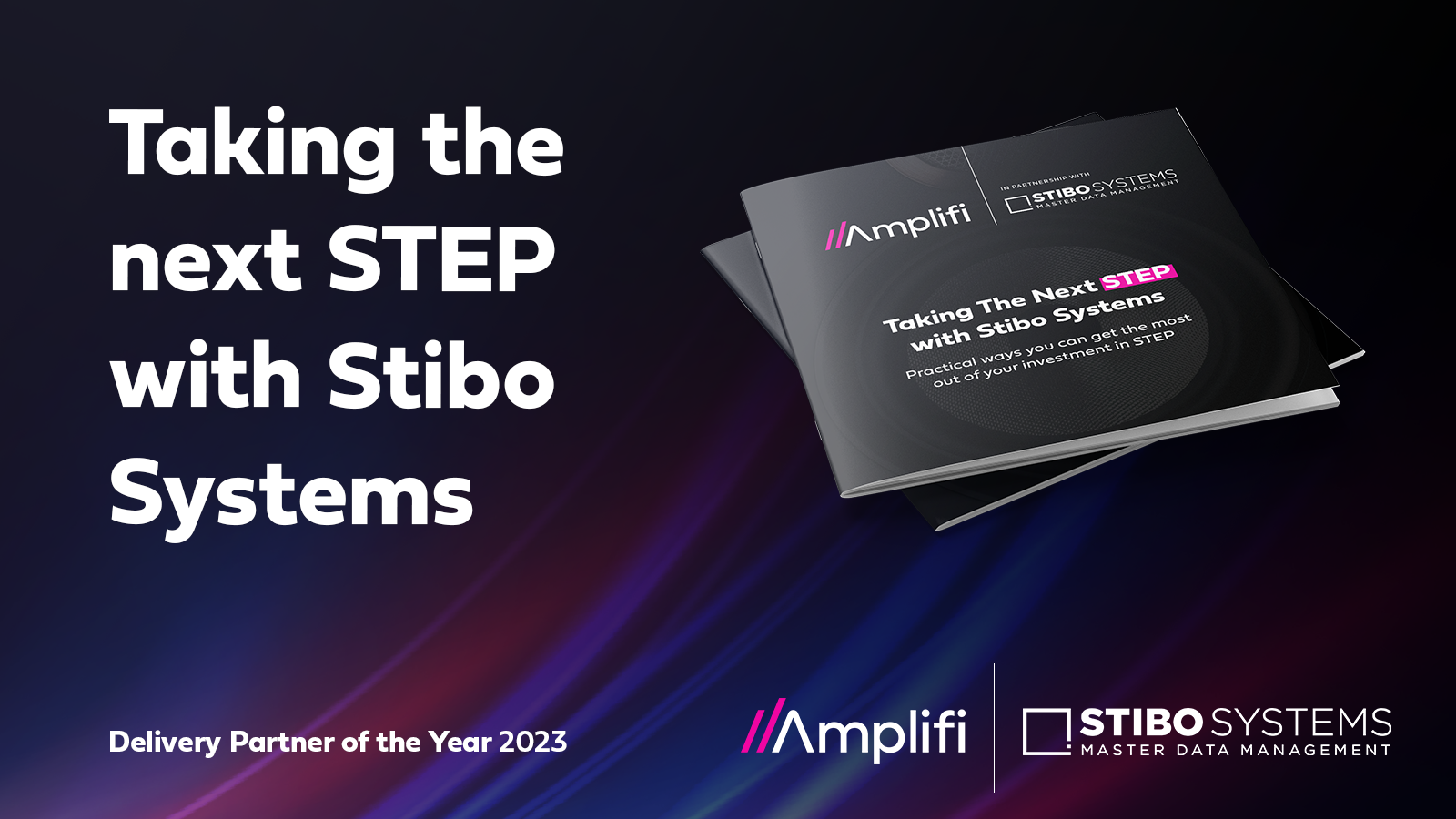Creating value for new and existing Stibo Systems STEP customers through expertise and consultancy
Amplifi and Stibo Systems have a long-standing relationship which has resulted in over 40 combined customers globally and experience of over 150 STEP implementations in the Amplifi team.
Due to the volume of both new and existing customers we have, Amplifi has a well-established Stibo Systems practice across both North America and Northern Europe.
In this interview, we caught up with Ametra Tipton, Practice Director for North America, and Catherine Cherry, MDM Practice Lead for Northern Europe, to find out more about how our Stibo Systems practice benefits our new and existing STEP customers.
Thanks both for taking part in this! First question, what do you think is the main benefit of Amplifi having a dedicated Stibo Systems practice in North America and Europe?
Catherine:
 For our customers, I see our role very much as a conduit between the Stibo Systems technology and what the business challenges are. We’re ultimately here to identify what the business needs, help to put a strategy in place for how master data management can address some of those challenges, and then bridge the gap between the two.
For our customers, I see our role very much as a conduit between the Stibo Systems technology and what the business challenges are. We’re ultimately here to identify what the business needs, help to put a strategy in place for how master data management can address some of those challenges, and then bridge the gap between the two.
Amplifi also has the benefit of being able to take a step back from an individual project and use our STEP expertise to make sure that we are approaching an implementation with best practices and longevity in mind.
Because the data industry is continually evolving, there may always be new or better ways to approach things; we can be developing technical accelerators, we can be aware of cross-industry trends and challenges, and our consultants are in a unique position to share their knowledge and experience.
Ametra:
Definitely – we’re connectors internally and externally, which is what I honestly love about my job.
We’ll have a chat going about a client project and someone will say “Hey, has anyone tackled this STEP use case before?” And then from there, you’ll find you may have worked on something like that in the past and you can talk people through it.
Recently someone was working on a project that was like one I’d done with STEP four or five years ago. It was his first time doing it, so in the practice lead role, I was able to share specific STEP knowledge.
Having a point person to do that, I think, helps with the efficiencies and how we function as an organization. I think it also gives our clients a lot of solace knowing that with our STEP practice, we’re going to figure things out and the implementations are going to be successful – not just initially but with future developments too.
Also, to your point Catherine, us being able to take a step back and say, are we doing this the best way and how could we be improving our approach is something that is hugely beneficial in building our relationship with Stibo too.
If I have a question about something, I feel comfortable going to them and saying, “Hey, this is what we’re working on, I’ve seen it done this way in the past, but we still had some open questions”. When both Amplifi and Stibo Systems are equally as invested in the success of the project, it’s hugely beneficial to our customers.
How does the STEP practice help with the different types of projects we’re working on with different customers?
Catherine:
We work with customers at every phase of an MDM project, who may be at varying levels of maturity and at all different stages on their data journeys. And of course, they can be across all different industry sectors too, each with its own unique challenges.
I might be talking to a client who is just considering what PIM or MDM solution might be right for them. At the same time, I’m involved in a project for a new implementation for another client. At the same time, I’m also supporting a long-standing Stibo Systems client who is expanding their use of STEP out into a new data domain or for a new region. We see every stage of the journey, sometimes even in a single week.
Having those concurrent conversations makes it easy to share knowledge more readily, provide perspective and help organizations to plan and implement for the long term.
Ametra:
I think that’s the key benefit of what we do. Because of the close partnership we have with Stibo, and because of the dedicated STEP practice our customers get the best of both; you get the leading technology, but you also get those combined years of expertise and consultancy to make sure you have continued and consistent success whatever stage you’re at.
As a practice lead, what are some of the recommendations you would make to an existing Stibo Systems customer to help them to get more out of STEP?
Ametra:
 I actually had the opportunity to do a lot of this at Connect (the Stibo Systems annual user conference) last year.
I actually had the opportunity to do a lot of this at Connect (the Stibo Systems annual user conference) last year.
Number one is understanding what they’re using STEP for today. If they’re an existing customer, chances are they probably started with PIM. I think that’s very common, to start with the product domain first. That’s essentially where the revenue is coming from for the organization, so they’re going to see a lot of value in managing their product data.
Even within a single domain, a platform like STEP has so much capability so understanding how STEP is used, discussing it in workshops with their business and data users, and finding out where it can be used more effectively for that single domain is key.
From there, the world is their oyster because STEP is a true platform, and you can manage so many different types of data.
If you feel like you’ve mastered product data and you’re in a good place with that solution, we can start mapping out other domains like customer data, vendor onboarding processes employee data…there are so many options.
A lot of that also depends on how mature at times organizations are because it takes a real push after product data to even be able to articulate the value that they’re going get out of managing other types of data. However, with our STEP experience, we’re able to help our clients construct those business cases and prove the value of using STEP for multiple domains.
Catherine:
I totally agree. I’d add that when it comes to identifying the benefits of an existing STEP implementation, before planning the next phase it’s equally important to revisit and reflect on the original business case.
Typically, a business case becomes just a formality to secure funding or obtain stakeholder buy-in, but I don’t necessarily always see organizations refer back to it once implementation is complete.
It’s a common challenge; things get descoped, things get pushed back and deprioritized, but at the end of a project, are you reflecting on whether you have achieved all of the objectives that you set out to?
If not, are you looking at ways that you might be able to improve it? There could be functionality in STEP that you’re not making the most of, or simple changes that could help to achieve those original business outcomes.
In the data industry, it can feel like new technology, trends, buzz words are emerging constantly. It can be tempting to jump onto the next thing to stay relevant or “keep up” with the competition. But without understanding what you’re looking to get out of it, how it fits into your existing data landscape, or, crucially, knowing whether a related initiative was even completed effectively, it can be hard to succeed. Or worse, risks building on an already unstable foundation.
Final question. As Amplifi’s practice leads, do you think companies truly understand the potential of STEP and how powerful it could be for them within their organisation?
Ametra:
Unfortunately, I don’t think so – but it’s our job to help them see that potential!
If we put ourselves in our clients’ shoes, they are hyper-focused on their needs at that time, and rightly so. A lot of the time, the expectation and hope on day zero is that STEP is going to change their lives. They’re going to master all of their data and STEP is going to be a central platform for their data ecosystem.
But the reality is, they start with phase one and then after that, it’s like, where are we? With Amplifi’s dedicated STEP practice, it’s our job to take them back to the use case and help them see the bigger picture.
There’s one customer we have that’s on a really cool data journey. They created a blueprint and roadmap very early on and had the whole conversation of this is what data means to us and this is why it’s critical. And every 12 to 18 months, they’re using STEP to start a new domain or they’re continuing to enhance what they have in place.
I just think it’s stellar to see things like that.
As a practice lead, being able to work with the person at that company that’s working on the location domain and helping them understand the things that have been done before, all the capabilities put in place around the product domain, helps them come in and contribute to this huge picture that someone had the foresight to say that’s where we’re going. And, with our help, STEP is the platform that they see as most capable of getting them there.
Catherine:
I agree with that approach 100%. In fact, because the capabilities of STEP are broad and customizable, I think there can be a risk of attempting to do too much at once rather than focusing on getting the basics right first. The most successful implementations understand the “why” for MDM for their business, have a well-communicated vision for the end state, and then a defined roadmap to get there. That vision for STEP and MDM can then evolve and grow along with the business, as original objectives are achieved, and new ones defined.
It can also be easy to overlook STEP’s capabilities to meet a new business challenge or scenario. Particularly when the challenge is impacting a different business department or relates to a new data domain. While a different technology or new platform can be appropriate in some circumstances, there can also be huge benefits to bringing data into a single place for a true multi-domain MDM solution. Among other things, it can open up opportunities to remove master data siloes, centralize management of relationships between connected data domains, and use this to derive valuable insight.
It’s our role as practice leads to have those conversations with our clients, find out if other business benefits could be delivered through STEP and, if so, support the development of a roadmap to achieve these
____
To find out more about the benefits of working with Amplifi and Stibo Systems, visit our dedicated Stibo Systems partner page or download our partnership guide here.


